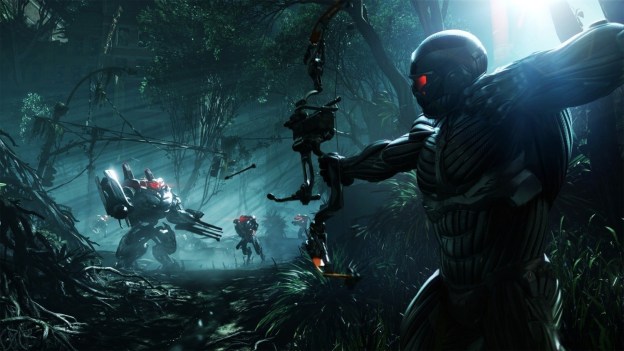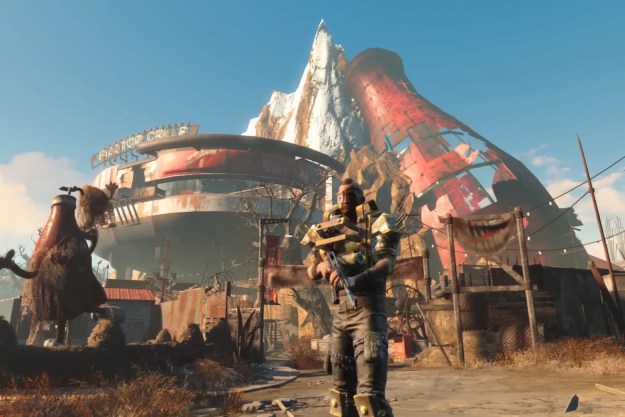
Story matters in video games, though statistics say otherwise. Estimates based on some recent games suggest that on average people only finish about 12 percent of the games they play. There are games like Civilization 5 that don’t really have an authored narrative in the campaign, but the most, from Borderlands 2 to Saints Row: The Third, are all about something. People say they’re there to just play the game, to hell with the story, but that isn’t really the case. It matters why we’re dressing up like a chef and assassinating people in Hitman: Absolution. We give a damn about the set up for fighting aliens in XCOM: Enemy Unknown. If we didn’t, every game would be Tetris, a bunch of abstract colors and shapes interacting. It’s just that most games don’t have very good stories to tell. This is why Crysis 3 is such a difficult game to judge. Doing the things you do in Crytek’s latest shooter is a good time, but the reason you’re doing them doesn’t matter at all.

What Am I Doing Again?
Once again, you’re placed in the role of Laurence Barnes, also known as the super soldier Prophet. After the adventures of the original Crysis and its sequel, Prophet is now less human than he is a crazy alien-human hybrid thanks to his nanosuit. In addition to making him look like a cross between Snake Eyes and Gary Oldman’s Dracula, the suit gives Prophet powers like the ability to turn (mostly) invisible, withstand getting shot for awhile, track multiple objects in the environment without looking directly at them, and hacking computers to name a few. Silly name and costume aside, those are some fun powers, especially now that they come with a sweet bow and arrow set that will turn invisible too.
Those skills were useful in past games when Prophet was fighting the Ceph, evil space squids that created his suit’s technology, and especially helpful here in the dystopian future of 2049. When the game opens, Prophet’s been in stasis for years as a paramilitary group has enslaved the world by controlling its power supply sourced, naturally, from captive aliens. Gruff old Brit Psycho wakes Prophet up and its off to the sealed island of Manhattan to shut down the power supply and break CELL’s hold on the world.

That’s the set up at least. It’s hard to get a bead on anything that happens in Crysis 3 because most of the time Prophet’s goals are pretty simple. A loud voice—Psycho, a random soldier, or some chick named Claire—are yelling at you about your next objective, but Crysis 3 never puts much thought into motivation or reason for moving forward. Psycho’s angry because CELL stole his old nanosuit. Why did they steal the nanosuit? Prophet has to go to the old evil medical facility where CELL cut people out of the suits so he can interface directly with the alien Ceph. Why though? Should we care? It’s not like we know anything about these people. They tell us they’ve been through horrors, but we never really see them. Even the myriad data files you find don’t do much to flesh out the world, since listening to or reading them requires you stop the game entirely. The juice is rarely worth the squeeze.
There’s never any rest from doom and gloom, so it’s impossible to get any emotional stability. Just like in Crysis 2, the world is ending RIGHT NOW from the get go in Crysis 3. When the stakes are always at maximum height, they don’t feel high at all. All that’s clear in Crysis 3 is that CELL soldiers are jerks, so are the Ceph, and you should proceed to the destination icon on your screen with all haste.
Over the River, Through the Woods, Have an Arrow in the Neck
Getting to that destination icon makes for a spectacularly good time, though. The ruins of New York aren’t very distinguished in Crysis 3, though they are beautiful in a sterile way. It looks like any number of jungle-ified cities from post-apocalyptic movies, comics and games, but lacking any real local flavor to make it feel tangibly like New York. It feels less like a real, dangerous place than the city of Crysis 2, but it is far more fun to play in. These stages are never as open and large as the islands in Crysis, but they are very wide. Tapping a button will let you scan an open field covered in grass and desiccated train cars, marking enemies, ammo and upgrades for your suit, and then you’re free to pick a path.
The broader arenas coupled with Crysis 3’s new bow weapon actually change the pace of the game significantly. Stealthy players can sneak under crumbled buildings, picking off enemies with their limited arrows, and then dodging into the open to retrieve them. The process of managing your suit’s energy (which depletes when you’re invisible), the aggression of your enemies, and your supplies is engrossing, and Crytek knows it. There’s very little clutter in Crysis 3, fewer upgrades for the suit to unlock and modifications for weapons change them less. Playing is all that matters, and the flow of one area into the next can cause you to lose track of time.

Crysis 3 peaks in a grand way, too, its second to last stage a vast sprawl set in an unrecognizable Hell’s Kitchen. You plunge off of skyscrapers and run across huge tracts of water and debris to shut down hidden alien anti-air guns or pursuing secondary objectives like helping soldiers with a tank past a minefield. The game never changes up its formula dramatically as you go in deeper, it just keeps broadening the play field, letting you explore different options. The goals are never as complex as similar stealth-vs-force games like Dishonored, the solutions never as novel as in Hitman, but that simplicity is its greatest merit. The problem remains, though: Since nothing’s at stake, Crysis’ good times feel strangely hollow. It’s gripping while the action is fast and heavy, but it’s impossible to remember what just happened as soon as the power’s off. The thrills can be extended in Crysis’ multiplayer, but that doesn’t fill up its emptiness.
Conclusion
It’s telling that Crysis 3’s writers don’t appear until after an army of coders and artists during the game’s credits. Crytek has always been about the technology first, the play second, and everything else after that. Even on PlayStation 3, the version reviewed here, the game is a visually stunning. In the subcategory of “Hopeless End of Days Science Fiction Shooters,” Crysis 3’s flow elevates it above Resistance, Metro 2033, and many others in a crowded field. As it is Crysis 3 is just a toy. A toy that’s fun to play with but it’s also a work that doesn’t mean anything.
Crytek are flawless craftsman, but what’s the point of all this visual artistry if it’s devoid of meaning? So much of the game is spent in grim, self-serious, but vapid cutscenes, so many swells of grand orchestral music and huge explosions, that you can’t help but feel Crytek at least in part wants Crysis to be about something. It isn’t, though, not yet. That’s what keeps it from being a truly good game. Until Crytek hones its storytelling chops alongside its graphical prowess, its games will continue to just be expertly made toys.
Score: 6.5 out of 10
(This game was reviewed on the PS3 via a copy provided by the publisher)


